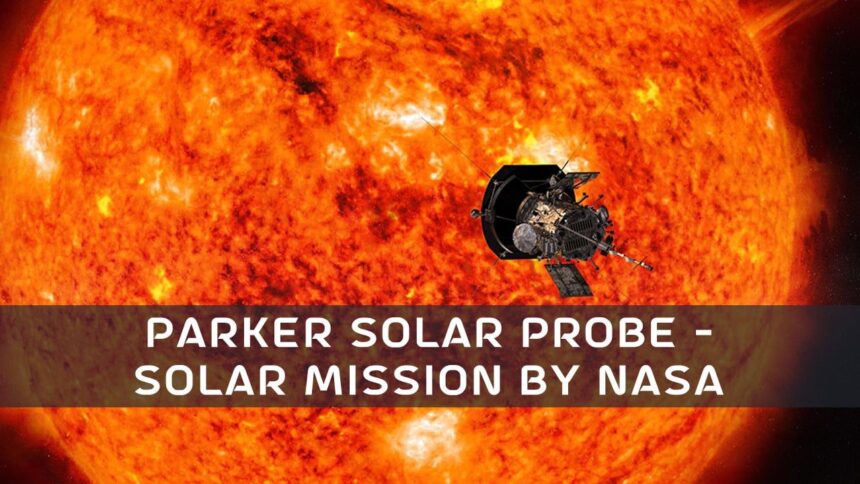A spacecraft has reached the Sun for the first time in history. Parker Solar Probe, a Solar mission by NASA has now collected particles and magnetic fields in the Sun’s upper atmosphere, known as the corona.
The latest achievement is a huge step forward for the Solar mission by NASA, Parker Solar Probe, and a giant leap forward for solar research. Touching the same material that makes up the Sun will help scientists understand more about our nearest star and its influence on the solar system, just like landing on the Moon did for scientists learning more about how it was formed.
●⫸ What is the recent solar mission by NASA?
Parker is making discoveries that other spacecraft couldn’t see because they were too far away, such as from within the solar wind, which is the flow of particles from the Sun that may influence us here on Earth.
Switchbacks, or magnetic zig-zag patterns in the solar wind, are frequent near the Sun, according to Parker’s findings in 2019. The how and where they developed, however, remained a mystery.
The Parker Solar Probe has now reached near enough to pinpoint one region where they originate: the solar surface, after lowering the distance to the Sun since then.
●⫸ What is Parker Solar Probe Mission?
Parker Solar Probe was launched in 2018 to delve deeper into the secrets of the Sun by journeying closer to it than any previous mission. Parker has arrived three years after its debut and decades after its conception.
The Sun, unlike the Earth, does not have a solid surface. It does, however, have a superheated atmosphere made up of solar material that is magnetically and gravitationally bound to the Sun.
Increased heat and pressure force the material away from the Sun to the point where gravity and magnetic fields are no longer powerful enough to keep it in place
The end of the solar atmosphere and the beginning of the solar wind are marked by the Alfvén critical surface. Solar material having enough energy to overcome that barrier produces the solar wind, which drags the Sun’s magnetic field with it as it speeds through the solar system, to Earth and beyond.
Importantly, the solar wind flows so quickly beyond the Alfvén critical surface that waves inside the wind can never travel fast enough to return to the Sun, severing their link.
●⫸ Objectives of the Parker Solar Probe Mission
On April 28, 2021, during its eighth flyby of the Sun, the Parker Solar Probe encountered specific magnetic and particle conditions at 18.8 solar radii (around 8.1 million miles) above the solar surface, indicating that it had crossed the Alfvén critical surface for the first time and had finally entered the solar atmosphere.
The Parker Solar Probe is part of NASA’s Living with a Star program, which aims to learn more about the Sun-Earth system’s effects on life and civilization. NASA’s Science Mission Directorate in Washington oversees the Living with a Star program, which is managed by the agency’s Goddard Space Flight Center in Greenbelt, Maryland.
The Solar mission by NASA, Parker Solar Probe mission is managed by NASA’s Johns Hopkins University Applied Physics Laboratory in Laurel, Maryland, which also planned, constructed, and controlled the spacecraft.
●⫸ The trajectory of Parker Solar Probe
Several times during the flyby, the Parker Solar Probe sailed into and out of the corona. This demonstrates that, contrary to popular belief, the Alfvén critical surface is not shaped like a smooth ball.
Rather, spikes and troughs wrinkle the surface. Scientists will be able to learn more about how events on the Sun influence the atmosphere and solar wind if they can figure out where these protrusions match up with solar activity coming from the surface.
Parker Solar Probe passed through a structure in the corona known as a pseudostreamer when it sank to just below 15 solar radii (about 6.5 million miles) from the Sun’s surface. Pseudostreamers are gigantic formations seen from Earth during solar eclipses that rise above the Sun’s surface.
As I passed through the pseudostreamer, I felt like I was flying into the eye of a cyclone. The circumstances quieted within the pseudostreamer, particles slowed, and the number of switchbacks decreased — a stark contrast to the hectic onslaught of particles the spacecraft normally faces in the solar wind.
●⫸ Information received
Some unexpected physics emerged even before the first pass into the corona. Parker Solar Probe obtained data on the origins of zig-zag-shaped formations in the solar wind known as switchbacks during recent solar encounters.
The photosphere, which is visible on the Sun’s surface, is one place where switchbacks form, according to the data.
By the time it reaches Earth, 93 million miles away, the solar wind is a constant stream of particles and magnetic fields. As it departs the Sun, the solar wind, on the other hand, is well-ordered and irregular.
The NASA-European Space Agency mission Ulysses flew over the Sun’s poles in the mid-1990s and detected several strange S-shaped bends in the magnetic field lines of the solar wind, which detoured charged particles on a zig-zag course as they exited the Sun.
For decades, astronomers believed that these sporadic switchbacks were unique to the Sun’s polar regions.
●⫸ Conclusion
Now that scientists know what to look for, Parker’s closer trips might provide additional information about switchbacks and other solar phenomena. Thanks to the data that will be provided soon, scientists will be able to peer into an area that is critical for superheating the corona and accelerating the solar wind to supersonic speeds.
Extreme space weather events, which might disrupt telecommunications and kill satellites circling Earth, would need corona measurements to understand and predict.

